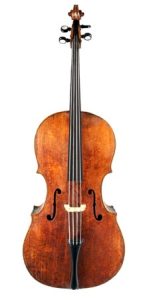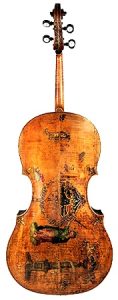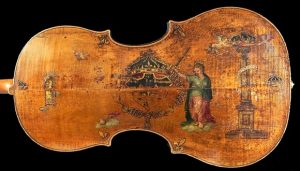This was an article originally produced by National Music Museum and adapted for this blog. Here is all you need to know about the violoncello by Andrea Amati.
Images from The Rawlins Gallery
The King Violoncello by Andrea Amati, Cremona, after 1538


It was in the workshop of Andrea Amati (ca. 1505-1577) in Cremona, Italy, in the middle of the 16th century that the form of the instruments of the violin family as we know them today first crystallized. The King, as it is now called, is the earliest bass instrument of the violin family known to survive, built perhaps as early as 1538, originally with only three strings. About 1560, it was painted to serve as one of a set of 38 stringed instruments built by Andrea Amati that were painted and gilded for the French court of King Charles IX (d. 1574) – his mother was Catherine de’ Medici, a member of the Italian family that directed the destiny of Florence (and, after 1569, of Tuscany) from the fifteenth century to 1737 – with the King’s emblems and mottoes. The set was used until it was dispersed during the French Revolution (1789). Only a few instruments from the set have survived.
Painting on back of the cello

The King was cut down in size–looking closely at the paintings on the back, one can see that wood was removed down the center, leaving the woman, representing “Justice,” without a waist or left arm–and “modernized” by Sébastian Renault, a Parisian luthier, in 1801.
Bass side of the cello

The letters on the bass side spell the word, “PIETATE” (Latin for piety). The letter, “K,” in the center rib stands for “Karolus” (King Charles IX of France). The cello’s neck was replaced in 1801, but the original scroll and pegbox were kept, retaining not only the original decoration, but also preserving the evidence that the instrument once had only three strings.
Treble side of the cello

The letters on the treble side spell the word “IVSTICIA” (or “JUSTICIA,” Latin for justice). The letter, “K,” in the center rib stands for “Karolus” (King Charles IX of France). The King was exhibited in London in 1872 and 1904, and in New York in 1968. In 1982, it was featured in an exhibition mounted for the Ente Triennale Internazionale degli Strumenti ad Arco at the Palazzo Comunale di Cremona, October 9-18. See: Andrea Mosconi and Laurence C. Witten, Capolavori di Andrea Amati (Cremona: Ente Triennale Internazionale degli Strumenti ad Arco, 1984), pp. 53-58 and 69. According to Charles Beare, the prominent London violin expert who heard the cello played in 1982, “I think the sound that came out of that instrument was perhaps the greatest ‘cello sound I have ever heard outside of one or two of the great Strad ‘cellos.”